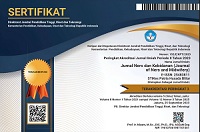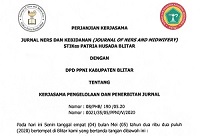Predisposition Factors Related to Stunting Preventing Behaviors
DOI:
https://doi.org/10.26699/jnk.v12i1.ART.p026-034Keywords:
Predisposition, Prevention, StuntingAbstract
Stunting is a child growth disorder characterized by a child's lack of height compared to children his age. Morbidity and mortality rates, decreased growth, learning achievement, increased risk of infectious and non-communicable diseases, and decreased productivity are all effects of stunting. This research aimed to find predisposing factors that contribute to stunting preventing behaviors. This research focused on the working area of Sidomulyo Inpatient Health Center. The research design was cross-sectional, with 95 mother subjects. The measurement used a questionnaire. Research results from bivariate analysis using chi square analysis showed that there was a correlation between age (p-value 0.022), occupation (p-value 0.024), education (p-value 0.000), and knowledge (p-value 0.015) with the level of stunting. It is recommended to the community and families who will have children under five that the mother's age, occupation, education and knowledge influence their behavior in preventing stunting. Health workers can provide counseling or education about predisposing factors related to stunting prevention behavior to their patients.
References
Adrizain, R., Faridah, L., Fauziah, N., Berbudi, A., Afifah, D. N., Setiabudi, D., & Setiabudiawan, B. (2024). Factors influencing stunted growth in children: A study in Bandung regency focusing on a deworming program. Parasite Epidemiology and Control, 26(June). https://doi.org/10.1016/j.parepi.2024.e00361
Agustina, N. (2022). Faktor-faktor Penyebab Kejadian Stunting pada Balita. https://yankes.kemkes.go.id/view_artikel/1529/faktor-faktor-penyebab-kejadian-stunting-pada-balita
Andriani, L., Nisa, S., Aprihatin, Y., Hamka, J. (2023). Pengaruh Negatif Stunting Terhadap Perkembangan Kognitif Dan Motorik Pada Anak Balita the Negative Effect of Stunting on Cognitive and Motoric Development in Children. Journal Of Medicine, 4(1), 1–12. https://doi.org/10.69922/asshiha.v4i1.47
Asefa, A., Girma, D., Kaso, A. W., Ferede, A., Agero, G., & Beyen, T. K. (2024). Prevalence of stunting and associated factors among under-five children in Robe Woreda, Arsi zone, Ethiopia. International Journal of Africa Nursing Sciences, 21(September), 100782. https://doi.org/10.1016/j.ijans.2024.100782
B, M. J., Ringo, E. S., & Tambunan, I. Y. B. (2022). Hubungan Pengetahuan Ibu Dengan Kejadian Stunting Pada Anak Umur 35-59 Bulan Di Wilayah Pustu Paniaran Kabupaten Tapanuli Utara Tahun 2022. Jurnal Kesehatan Tambusai, 3(3), 378–383. https://doi.org/10.31004/jkt.v3i3.6412
Beal, T., Tumilowicz, A., Sutrisna, A., Izwardy, D., & Neufeld, L. M. (2018). A review of child stunting determinants in Indonesia. Maternal and Child Nutrition, 14(4), 1–10.
https://doi.org/10.1111/mcn.12617
Dewi, N. W. E. P., & Ariani, N. K. S. (2021). Hubungan Pengetahuan Ibu Tentang Gizi Menurunkan Resiko Stunting Pada Balita di Kabupaten Gianyar. Jurnal Menara Medika, 3(2), 148–154.
Direktorat Jenderal Pelayanan Kesehatan Kementerian Kesehatan. (2023). Sumber Zat Gizi Penting bagi Anak Balita Menunjang Pertumbuhan Normal. https://yankes.kemkes.go.id/view_artikel/2832/sumber-zat-gizi-penting-bagi-anak-balita-menunjang-pertumbuhan-normal
Dwi Putri, V., & Tiara Levia, A. (2022). Hubungan Berat Badan Lahir Terhadap Kejadian Stunting Pada Balita Usia 2-5 Tahun. Cendekia Medika: Jurnal Stikes Al-Ma`arif Baturaja, 7(2), 147–151. https://doi.org/10.52235/cendekiamedika.v7i2.192
Fitri, M., Ulsafitri, Y., Andriani, D., Kesehatan, F. I., Mohammad, U., Bukittinggi, N., & Bukittinggi, M. N. (2023). Perilaku Pencegahan Stunting Pada Ibu Hamil Trimester Ii Di Bpm Bukittinggi. Human Care Journal, 8(2), 387–395. https://doi.org/10.32883/hcj.v8i1.2311
Hagos, S., Hailemariam, D., WoldeHanna, T., & Lindtjørn, B. (2017). Spatial heterogeneity and risk factors for stunting among children under age five in Ethiopia: A Bayesian geo-statistical model. PLoS ONE, 12(2), 1–18. https://doi.org/10.1371/journal.pone.0170785
Hidayati, R., & Hasibuan, R. (2022). Hubungan Tingkat Pengetahuan Ibu Terhadap Stunting Pada Balita Usia 2-4 Tahun. Jurnal Pendidikan, 6(2), 218–221. https://doi.org/10.35568/earlychildhood.v6i2.2408
Kementerian Kesehatan RI. (2017). Buku Saku Pemantauan Status Gizi Tahun 2017. Buku Saku Pemantauan Status Gizi Tahun 2017, 1–150.
Kementerian Kesehatan RI. (2018). Cegah Stunting dengan Perbaikan Pola Makan, Pola Asuh dan Sanitasi. https://sehatnegeriku.kemkes.go.id/baca/rilis-media/20180407/1825480/cegah-stunting-dengan-perbaikan-pola-makan-pola-asuh-dan-sanitasi-2/
Kementrian Kesehatan RI. (2018). Hasil Utama Laporan Riskesdas 2018. In Badan Penelitian dan Pengembangan Kesehatan Departemen Kesehatan Republik Indonesia. https://doi.org/1 Desember 2013
Laksono, A. D., Wulandari, R. D., Amaliah, N., & Wisnuwardani, R. W. (2022). Stunting among children under two years in Indonesia: Does maternal education matter? PLoS ONE, 17(7 July), 1–11. https://doi.org/10.1371/journal.pone.0271509
Lestari, W., Samidah, I., & Diniarti, F. (2022). Hubungan Pendapatan Orang Tua dengan Kejadian Stunting di Dinas Kesehatan Kota Lubuklinggau. Jurnal Pendidikan Tambusai, 6 Nomor 1(2614–3097), 3273–3279. https://doi.org/10.31004/jptam.v6i1.3388
Muhamad, F., Wahyudin, & Aliyah. (2020). Hubungan Tingkat Pendidikan dan Pekerjaan Ibu Balita dengan status gizi balita di Wilayah Kerja Puskesmas X Kabupaten Indramayu. Prosiding Seminar Nasional Kesehatan, 1, 9–15.
Ni’mah, C., & Muniroh, L. (2016). Hubungan Tingkat Pendidikan, Tingkat Pengetahuan Dan Pola Asuh Ibu Dengan Wasting Dan Stunting Pada Balita Keluarga Miskin. Media Gizi Indonesia, 10(1), 84–90. https://doi.org/10.20473/mgi.v10i1.84-90
Nurfatimah, N., Anakoda, P., Ramadhan, K., Entoh, C., Sitorus, S. B. M., & Longgupa, L. W. (2021). Perilaku Pencegahan Stunting pada Ibu Hamil. Poltekita : Jurnal Ilmu Kesehatan, 15(2), 97–104. https://doi.org/10.33860/jik.v15i2.475
Ramadhan, M. F., Dimiati, H., Hidayaturrahmi, H., & Indah, R. (2024). The Correlation between Stunting, Maternal Knowledge, and Nutritional Care in Aceh, Indonesia. Amerta Nutrition, 8(4), 513–518. https://doi.org/10.20473/amnt.v8i4.2024.513-518
Rohmatun, N. Y. (2014). Hubungan tingkat pendidikan ibu dan pemberian asi eksklusif dengan kejadian. In Program studi Ilmu Gizi Fakultas Ilmu Kesehatan Universitas Muhammmadiyah Surakarta.
Simamora, V., Santoso, S., & Setiyawati, N. (2019). Stunting and development of behavior. International Journal of Public Health Science, 8(4), 427–431. https://doi.org/10.11591/ijphs.v8i4.20363
Sudikno, Irawan, I. R., Setyawati, B., Sari, Y. D., Wiryawan, Y., Puspitasari, D. S., Widodo, Y., Ahmadi, F., Rachmawati, R., Amaliah, N., Arfines, P. P., Rosha, B. C., Pambudi, J., Aditianti, Julianti, E. D., & Safitri, A. (2019). Laporan Akhir Penelitian Status Gizi Balita Tahun 2019. Kemenkes RI, 1–150. https://cegahstunting.id/unduhan/publikasi-data/
Tafese, Z., Alemayehu, F. R., Anato, A., Berhan, Y., & Stoecker, B. J. (2020). Child feeding practice and primary health care as major correlates of stunting and underweight among
- To 23-month-old infants and young children in food-insecure households in ethiopia. Current Developments in Nutrition, 4(9), nzaa137. https://doi.org/10.1093/cdn/nzaa137
Tebi, Dahlia, Wello, E. A., Safei, I., Rahmawati, Sri Juniarty, & Akhmad Kadir. (2022). Literature Review Faktor-Faktor yang Mempengaruhi Terjadinya Stunting pada Anak Balita. Fakumi Medical Journal: Jurnal Mahasiswa Kedokteran, 1(3), 234–240. https://doi.org/10.33096/fmj.v1i3.70
UNICEF. (2016). Levels and trends in child malnutrition. 1–8. https://www.who.int/nutgrowthdb/estimates/World
Utami, R. A., Setiawan, A., & Fitriyani, P. (2019). Identifying causal risk factors for stunting in children under five years of age in South Jakarta, Indonesia. Enfermeria Clinica, 29(xx), 606–611. https://doi.org/10.1016/j.enfcli.2019.04.093
Vaivada, T., Akseer, N., Akseer, S., Somaskandan, A., Stefopulos, M., & Bhutta, Z. A. (2020). Stunting in childhood: An overview of global burden, trends, determinants, and drivers of decline. American Journal of Clinical Nutrition, 112, 777S-791S. https://doi.org/10.1093/ajcn/nqaa159
Wulandari, N. A., Yeni Kartika Sari, & Miftah Chairunnisa. (2022). The “Kakek Nenek Asuh” Program increases Community Knowledge about Stunting and Nutrition for Children under five in Sengon Village. Community Development Journal, 6(3), 79–85. https://doi.org/10.33086/cdj.v6i3.3494

Downloads
Published
How to Cite
Issue
Section
License
Copyright (c) 2025 Jurnal Ners dan Kebidanan (Journal of Ners and Midwifery)

This work is licensed under a Creative Commons Attribution-ShareAlike 4.0 International License.


 Google Scholar
Google Scholar Scopus
Scopus Sinta
Sinta ORCID
ORCID





